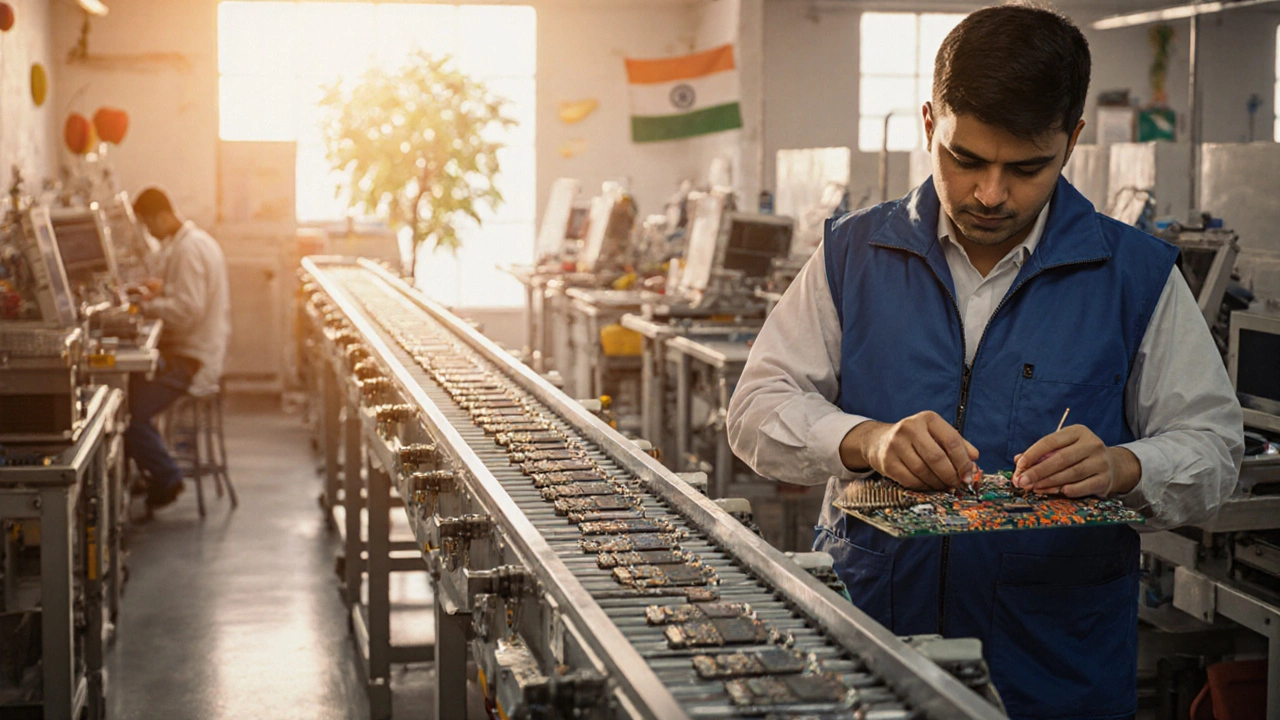 Oct, 8 2025
Oct, 8 2025
Manufacturing Cost Calculator
Enter Your Product Details
Fill in the fields below to calculate the total landed cost for manufacturing your product.
Cost Breakdown
- Base Labor Cost
- Raw Material Cost
- Energy & Utilities
- Logistics
- Compliance & Quality
- Total Landed Cost
Finding the cheapest manufacturing locations can make the difference between a modest profit and a thriving export business. Companies of every size ask the same question: where can I produce my goods for the lowest total cost without sacrificing quality or delivery speed? This guide breaks down the top low‑cost manufacturing hubs in 2025, walks through the cost drivers you need to measure, and offers a practical checklist so you can pick the right spot for your product line.
What "cheapest" really means in manufacturing
Cost isn’t just about the hourly wage you pay to a factory worker. The total landed cost includes labor, raw material prices, energy, logistics, customs duties, and compliance overhead. To compare locations fairly, you need a manufacturing cost index that aggregates these factors into a single number. In 2025 the global average index sits at 100; a country scoring 70 is 30% cheaper overall, while a score of 120 is 20% more expensive.
Top low‑cost manufacturing hubs in 2025
Below are the eight countries that consistently rank below the global cost average while offering decent infrastructure and a skilled labor pool.
- Vietnam has surged past China in labor affordability, averaging $2.40 per hour for assembly workers in 2025.
- India provides a massive engineering talent pool at $1.90 per hour for electronics assembly.
- Bangladesh remains the cheapest option for garment and textile production, with wages near $1.70 per hour.
- Mexico offers proximity to the US market and labor costs around $4.30 per hour for automotive parts.
- Turkey combines moderate wages ($5.20 per hour) with a customs union that eases EU access.
- Poland delivers EU‑standard quality at $6.00 per hour for electronics and appliances.
- United States may sound expensive, but for high‑value, low‑volume items the total cost can be competitive once you factor in shorter lead times and lower logistics fees.
- China still holds a dominant market share; its average labor cost is $5.70 per hour, but massive scale and supply‑chain depth keep overall costs low for many categories.
How to calculate the true landed cost
Use this five‑step formula to avoid hidden expenses:
- Base labor cost = hourly wage × number of hours needed per unit.
- Add raw material markup = material price × (1+local taxes).
- Factor energy & utilities = average kWh cost × estimated consumption per unit.
- Include logistics = freight + inland transport + customs clearance fees.
- Apply compliance & quality costs = certifications, inspections, and any needed redesigns.
When you plug real numbers from the table below, the cost gaps become crystal clear.
| Country | Avg. Labor Cost (USD/hr) | Manufacturing Cost Index | Key Industries | Pros | Cons |
|---|---|---|---|---|---|
| Vietnam | 2.40 | 68 | Textiles, Electronics | Fast-growing skilled pool, stable FTAs | Infrastructure still catching up |
| India | 1.90 | 65 | Pharma, IT hardware | Huge engineering talent, low wages | Complex customs, variable power reliability |
| Bangladesh | 1.70 | 60 | Apparel, Footwear | World‑lowest garment wages | Limited diversification beyond textiles |
| Mexico | 4.30 | 78 | Automotive, Electronics | Near US market, NAFTA/USMCA benefits | Higher wages than Central America |
| Turkey | 5.20 | 80 | Apparel, Machinery | Customs union with EU, solid logistics | Currency volatility |
| Poland | 6.00 | 85 | Electronics, Home appliances | EU regulations compliance, skilled workforce | Higher labor cost than Eastern Europe peers |
| United States | 21.00 | 95 | High‑tech, Aerospace | Shortest lead times, strong IP protection | Labor cost premium |
| China | 5.70 | 70 | Consumer electronics, Toys | Massive supplier ecosystem, mature logistics | Geopolitical risk, rising wages |
Beyond cost: other factors that matter
Choosing a location solely on labor price can backfire. Consider these additional drivers:
- Supply‑chain proximity: Shorter distances to key component suppliers cut both freight and inventory holding costs.
- Trade agreements: Nations in free‑trade zones enjoy reduced tariffs, which can shave 5‑15% off landed price.
- Political stability: Sudden policy shifts (e.g., export bans) disrupt production cycles.
- Skill level: Higher‑precision products demand trained technicians; wage differentials narrow as skills rise.
- Intellectual property protection: For high‑tech goods, weak IP regimes increase risk of design theft.
Step‑by‑step checklist for selecting a manufacturing base
- Define product complexity - simple assembly vs. high‑precision engineering.
- Identify critical components and map where they’re produced.
- Run a cost model using the five‑step formula above for each candidate country.
- Score each location on trade‑agreement access, logistics quality, and political risk (scale 1‑5).
- Calculate a weighted total score: 60% cost, 20% logistics, 10% risk, 10% skill.
- Select the top‑ranked country, then pilot a small batch to validate quality and lead‑time.
Most SMEs find that a 1‑3% margin improvement after the pilot justifies the effort of setting up a new supply line.

Common pitfalls and how to avoid them
Even seasoned exporters stumble over these traps:
- Under‑estimating hidden fees: Customs brokers, inspection agencies, and local taxes can add 8‑12% to the invoice. Always ask for a full cost breakdown.
- Assuming wages stay static: In Vietnam and India, wages have risen 4‑5% annually since 2020. Build a 3‑year forecast into your model.
- Ignoring quality variance: Cheap labor doesn’t equal poor quality, but inadequate training can raise defect rates. Incorporate a 1‑2% rework cost buffer.
- Skipping on‑site audits: Remote assessments miss factory floor realities. Schedule a physical audit before signing contracts.
Future outlook: where cost leaders may shift
Geopolitical tensions and climate policies are reshaping the cost map. By 2030, the following trends are likely:
- Eastern Europe (e.g., Romania, Bulgaria) will become more attractive as EU labor costs stabilize.
- African nations such as Kenya and Ethiopia are investing in textile clusters, promising sub‑$2 per hour wages by 2028.
- Automation will compress the wage gap: countries with higher robot adoption (South Korea, Germany) will stay competitive even with higher labor rates.
Staying flexible-by keeping design files digital and maintaining multiple supplier relationships-will let you pivot as new low‑cost hubs emerge.
Frequently Asked Questions
What is the cheapest country to manufacture garments?
Bangladesh consistently offers the lowest labor rates for apparel, averaging $1.70 per hour, and benefits from a mature garment supply chain.
How do trade agreements affect manufacturing cost?
Free‑trade agreements can eliminate or reduce tariffs by 5‑15%, directly lowering the landed cost. For example, Mexico’s participation in USMCA gives duty‑free access to the US market for most goods.
Is manufacturing in China still cost‑effective?
Yes, for high‑volume consumer electronics and toys. While wages have risen to about $5.70 per hour, China’s deep supplier ecosystem and advanced logistics keep the overall cost index near 70, making it competitive for many categories.
What hidden costs should I expect when sourcing from Vietnam?
Beyond labor, factor in inland freight to ports (often 3‑4% of total cost), customs clearance fees, and occasional language‑related project management overheads. A safe estimate adds 8‑10% to the quoted factory price.
How can I reduce quality‑related rework expenses?
Implement a two‑stage inspection: a pre‑production audit followed by a 100% in‑process check. Investing in a short training session for line workers can cut defect rates by up to 30%, saving significant rework costs.
Will automation make low‑cost countries irrelevant?
Automation narrows the wage gap for high‑precision work, but labor‑intensive sectors like textiles still benefit from cheap human labor. The best strategy is a hybrid approach: automate the most repetitive steps while keeping assembly in low‑cost regions.